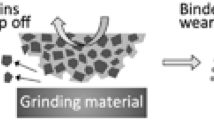Abstract
Freeform surface grinding is one of the commonly used dental medical manufacturing processes. In dentistry machining, zirconia is one of main workpieces used for artificial teeth. Machining process for grinding of the ceramic usually takes a long time. In order to reduce this production time, it is critical to apply proper grinding parameters while maintaining high quality of machined artificial teeth. Required material removal rate (MRR) for workpiece can be used to determine the grinding parameters. However, it has been hard to find grinding parameters achieving a proper MRR of complex 3D models like as human teeth. In this study, MRR is predicted by using geometric data in the engagement region between machining bur and its workpiece while the MRR varies all along the tool path. Simulations of the machining time shows that the machining time can be reduced by adjusting the bur’s feed rate to maintain the predicted MRR.
Similar content being viewed by others
Reference
L. A. Dobrzański and Ł. Reimann, Digitization procedure of creating 3D model of dental bridgework reconstruction, J. Achiev. Mater. Manuf. Eng., 55 (2012) 469–476.
N. Lebon, L. Tapie, E. Vennat and B. Mawussi, Influence of CAD/CAM tool and material on tool wear and roughness of dental prostheses after milling, J. Prosthet. Dent., 114 (2015) 236–247.
L. Wang and L. Wang, Denture feature modeling and processing by reverse engineering technology a case study, Proceedings 2013 International Conference on Mechatronic Sciences, Electric Engineering and Computer (MEC) (2013) 3148–3151.
T. Miyazaki, Y. Hotta, J. Kunii, S. Kuriyama and Y. Tamaki, A review of dental CAD/CAM: current status and future perspectives from 20 years of experience, Dent. Mater. J., 28 (2009) 44–56.
P. F. Manicone, P. R. Iommetti and L. Raffaelli, An over view of zirconia ceramics: Basic properties and clinical applications, J. Dent., 35 (2007) 819–826.
I. Denry and J. R. Kelly, State of the art of zirconia for dental applications, Dent. Mater., 24 (2008) 299–307.
T. Miyazaki, T. Nakamura, H. Matsumura, S. Ban and T. Kobayashi, Current status of zirconia restoration, J. Prosthodont. Res., 57 (2013) 236–261.
S. Malkin and T. W. Hwang, Grinding mechanisms for ceramics, CIRP Ann. - Manuf. Technol., 45 (1996) 569–580.
J. E. Mayer and G. P. Fang, Effect of grinding parameters on surface finish of ground ceramics, CIRP Ann. - Manuf. Technol., 44 (1995) 279–282.
Y. J. Zhan, Y. Li, H. Huang and X. P. Xu, Energy and material removal mechanisms for the grinding of cemented carbide with brazed diamond wheels, Solid State Phenom., 175 (2011) 58–66.
J. Chen, J. Shen, H. Huang and X. Xu, Grinding character istics in high speed grinding of engineering ceramics with brazed diamond wheels, J. Mater. Process. Technol., 210 (2010) 899–906.
L. T. Tunc and E. Budak, Extraction of 5-axis milling con ditions from CAM data for process simulation, Int. J. Adv. Manuf. Technol., 43 (2009) 538–550.
H. Erdim and A. Sullivan, High accuracy computation of geometric properties of cutter workpiece intersection using distance fields for NC milling, Procedia CIRP, 4 (2012) 84–89.
A. Sullivan, H. Erdim, R. N. Perry and S. F. Frisken, High accuracy NC milling simulation using composite adaptively sampled distance fields, Comput. Des., 44 (2012) 522–536.
S. J. Wou, Y. C. Shin and H. El-Mounayri, Ball end milling mechanistic model based on a voxel-based geometric representation and a ray casting technique, J. Manuf. Process., 15 (2013) 338–347.
H. Erdim and A. Sullivan, Cutter workpiece engagement calculations for five-axis milling using composite adaptively sampled distance fields, Procedia CIRP, 8 (2013) 438–443.
E. Aras and A. Albedah, Extracting cutter/workpiece engagements in five-axis milling using solid modeler, Int. J. Adv. Manuf. Technol., 73 (2014) 1351–1362.
Y. Boz, H. Erdim and I. Lazoglu, A comparison of solid model and three-orthogonal dexelfield methods for cutter-workpiece engagement calculations in three- and five-axis virtual milling, Int. J. Adv. Manuf. Technol., 81 (2015) 811–823.
X. Gong and H. Y. Feng, Cutter-workpiece engagement determination for general milling using triangle mesh modeling, J. Comput. Des. Eng., 3 (2016) 151–160.
E. Bagci and E. U. Yüncüoğlu, The effects of milling strategies on forces, material removal rate, tool deflection, and surface errors for the rough machining of complex surfaces, Stroj. Vestnik/Journal Mech. Eng., 63 (2017) 643–656.
J. Stori and P. Wright, Constant engagement tool path generation for convex geometries, J. Manuf. Syst., 19 (2000) 172–184.
M. Tolouei-rad, Efficient CNC milling by adjusting material removal rate, Eng. Technol., 5 (2011) 342–346.
H. S. Park, B. Qi, D. V. Dang and D. Y. Park, Development of smart machining system for optimizing feedrates to minimize machining time, J. Comput. Des. Eng., 5 (2018) 299–304.
S. E. Layegh K., H. Erdim and I. Lazoglu, Offline force control and feedrate scheduling for complex free form surfaces in 5-axis milling, Procedia CIRP, 1 (2012) 96–101.
Acknowledgments
This work is supported by DDS, Inc., in Seoul, Korea. In part, this work is also supported by Priority Research Program (NRF-2018R1A6A1A03025526) through National Research Foundation of Korea (NRF) under Ministry of Education, Science, and Technology.
Author information
Authors and Affiliations
Corresponding author
Additional information
Recommended by Associate Editor Yongho Jeon
Sangbeom Nam received his M.S. from School of Mechatronics Engineering, Korea University of Technology and Education in 2019, where he is also in seeking of his Ph.D. His research interests include machining of materials, dental crown machining and application.
Byungki Kim received the B.S. degree from Yonsei University, the M.S. degree from KAIST, South Korea, and the Ph.D. degree from the Georgia Institute of Technology, Atlanta, GA, USA, all in mechanical engineering. He was an Assistant Professor of Mechanical Engineering with the University of Massachusetts, Lowell, MA, USA. He is currently an Associate Professor of Mechatronics Engineering with the Korea University of Technology and Education. His research interest includes nanocomposites, smart materials, and micro systems.
Rights and permissions
About this article
Cite this article
Nam, S., Kim, B. Design of material removal rate to reduce machining time of dental crown. J Mech Sci Technol 33, 3423–3434 (2019). https://doi.org/10.1007/s12206-019-0637-y
Received:
Revised:
Accepted:
Published:
Issue Date:
DOI: https://doi.org/10.1007/s12206-019-0637-y




